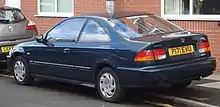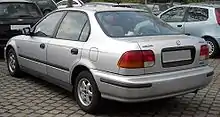Honda Civic (sixth generation)
The sixth generation Honda Civic was introduced in 1995 with 3-door hatchback, 4-door sedan and 2-door coupe body styles, replicating its predecessor's lineup. A 5-door hatchback was also produced to replace the Honda Concerto hatchback in Europe but this model, while using the same design language as the rest of the Civic range, was quite distinct, instead being a hatchback version of the Honda Domani, sharing that car's platform which was related to the fifth-generation (EG/EH/EJ) Civic. The Domani replaced the sedan version of the Concerto in Japan while the sedan version of the Concerto was directly replaced by the sixth generation Civic sedan in other markets. Two wagons were also made available; the JDM Orthia, based on the Civic sedan/3-door hatchback line, and a 5-door hatchback/Domani-based model, sold as the Civic Aerodeck, in Europe. Neither were offered in North America. The Civic 5-door hatchback also formed the basis for the 1995 Rover 400 although the 4-door sedan version of the Rover was quite distinct from the Domani.
| Honda Civic Sixth generation (EJ/EK/EM) | |
|---|---|
 | |
| Overview | |
| Manufacturer | Honda |
| Also called | Honda Ballade (South Africa) Honda Civic Ferio (sedan, Japan & Indonesia) Yancheng YC7150 (China; JV) |
| Production | September 1995 – August 2000 |
| Model years | 1996–2000[1] |
| Assembly | Swindon, United Kingdom (HUM) Suzuka, Japan East Liberty, Ohio, U.S. (ELAP) Alliston, Ontario, Canada (HCM) Ayutthaya, Thailand North Jakarta, Indonesia Lahore, Pakistan (Honda Atlas) Aragua, Venezuela Sumaré, Brasil (Honda Brazil) South Africa Hsinchu, Taiwan Nelson, New Zealand (Honda New Zealand) Gebze, Turkey (Honda Gebze Plant) Santa Rosa City, Laguna, Philippines, Kuala Lumpur, Malaysia Guangzhou, Guangdong, China |
| Designer | Masakazu Udagawa; Yoshi Kigoyoshi (1993)[2] |
| Body and chassis | |
| Class | Compact car |
| Body style | 2-door coupe (EJ6/7/8/EM1) 3-door hatchback (EJ6/EK1/2/3/4/9) 4-door sedan (EJ6/9) 5-door liftback (Domani based, MA/MB/MC) 5-door wagon (Orthia) 5-door wagon (Aerodeck - Domani based) |
| Layout | Front-engine, front-wheel-drive / four-wheel-drive |
| Related | Honda City Honda CR-V Honda Domani Honda Integra Honda Integra SJ Honda Orthia Honda Partner Acura EL Isuzu Gemini Isuzu Vertex Rover 200 Rover 400 |
| Powertrain | |
| Engine | 1.3 L D13B4 I4 1.4 L D14A3/A4/A7/A8 I4 1.5 L D15Z4/Z6 I4 1.6 L D16Y4 I4 (AUS version) 1.6 L D16Y5/Y7/Y8 I4 1.6 L B16A2 I4 1.6 L B16B VTEC I4 |
| Transmission | 5-speed manual 4-speed automatic CVT - HX only |
| Dimensions | |
| Wheelbase | 103.2 in (2,621 mm) |
| Length | 164.5 in (4,178 mm) (1995-98 hatchback) 164.2 in (4,171 mm) (1999–2000 hatchback) 175.1 in (4,448 mm) (coupe & sedan) |
| Width | 67.1 in (1,704 mm) (Int'l) 66.7 in (1,694 mm) (Japan) |
| Height | 54.1 in (1,374 mm) (coupe) 54.7 in (1,389 mm) (sedan) |
| Curb weight | 2,519 lb (1,143 kg) |
| Chronology | |
| Predecessor | Honda Civic (fifth generation) |
| Successor | Honda Civic (seventh generation) |
At its introduction in 1995, it won the Car of the Year Japan Award for the third time.
Trim packages and equipment (North America)

_GLi_hatchback_(24586633559).jpg.webp)

Coupe: Trims available in the coupe body style were the EJ6 (US DX, Canadian DX and DX-G), EJ7 (US HX), EJ8 (US EX, Canadian Si) and EM1 (only 1999 and 2000; US Si, Canadian SiR, Australian VTi-R).
Hatchback: Trims available in the hatchback body style were the EJ6 (US CX and DX, Canadian CX/CX-G/DX/SE), EJ9[3] (1.4L SOHC model), EK1 (1.5L SOHC VTEC-E model), EK2 (1.3L model), EK3 (1.5L SOHC VTEC-E model), EK4 (Japanese SiR, European SiR and/or VTi, Australian and New Zealand VTi-R), EK6 (Japanese 1.6L SOHC model), EK7 (Japanese 1.6L SOHC model) and the EK9 (Japanese Type R).
Sedan: Trims available in the sedan body style were the EJ6 (US DX/LX/VP, Canadian EX/LX), EJ8 (US EX), EJ9 (1.4L SOHC model), EK1 (1.5L SOHC VTEC-E model), EK2 (1.3L model), EK3 (1.5L SOHC model), EK4 (Japanese Si, European SiR and/or VTi), EK5 (Japanese 1.6L SOHC 4WD model), EK8 (Japanese 1.6L SOHC model) and EN1 (US GX).
CX: The base trim package, available as a hatchback only. Appointed very sparingly (no standard radio or power steering), it came equipped with 13-inch wheels, 4-wheel double wishbone suspension, dual airbags, split/folding rear seat, and seating for five people. In 1997, the CX added 14-inch wheels as standard equipment. In 2000, the CX added tilt steering as standard equipment.[4]
DX: Available as a hatchback, coupé, or sedan. It included all standard equipment from CX plus tilt steering and AM/FM radio. Power steering was standard on all sedans, and on the coupes when ordered with automatic transmission. For 1997, the DX added 14-inch wheels as standard equipment.[5]
LX: Available as a four-door only. It included all standard equipment from DX plus 14-inch wheels, power windows, power locks, power mirrors, power steering, front stabilizer bar, front center armrest with storage compartment, cargo area light, cruise control, and tachometer. For 1997, the LX added air conditioning as standard equipment.
EX: Available as a coupé or sedan. It included all standard equipment from LX plus a higher-horsepower SOHC VTEC engine, power sunroof, air conditioning, remote entry system, plus body-colored side mirrors and side molding. ABS was standard on sedan only and optional on the coupe if equipped with an automatic transmission. For 1999, the EX added a CD player as standard equipment.[6]
HX: Available as coupé only, this trim package was specially tooled for higher fuel efficiency. It was the only trim available with a CVT (continuously variable transmission), though customers could also choose a 5-speed manual transmission. It included all standard equipment from DX, plus a slightly higher horsepower VTEC-E engine, alloy wheels, power windows, power locks, power steering, and tachometer.[7][8]
GX: Introduced in 1997 and available as a sedan for fleet-purchase only, this trim package was specially designed to run on natural gas. See Honda Civic GX for detail and references.
VP: Introduced in 1998 and available as a sedan only, this trim was designed as a “Value Package” above the DX. It included all standard equipment from DX plus automatic transmission, power locks, CD player, air conditioning, keyless entry, and special paint.
Most trim packages had a standard AM/FM radio in the center dashboard with a backlit LCD display (except CX had no radio), but a slave cassette player or CD player was available through dealer-installed options and was installed in the forward portion of the console and was hidden from view when the cup holder was open. EX trims had the slave cassette player standard. Dealers also offered AM/FM cassette and AM/FM CD decks to replace the stock radio. All vehicles were equipped with four speakers (except for the EX which included two extra tweeters located on the front doors), radio wiring (prep), and an antenna regardless of whether or not they had a radio.
Si

After a brief hiatus, the Civic Si reappeared in 1999, available as a coupé only. With the adoption of the VTi badge in Europe and the SiR and Type R badges in Japan for the sports variants of Civics, the Si became primarily a US-specific badge, a branding trend that would continue in subsequent Civic generations. Accelerating from 0-60 mph (97 km/h) in 7.1 seconds, the 1999 Civic Si trim package featured a 1.6-litre B16A2 engine that made 160 hp (119 kW) at 8,000 rpm and 111 ft-lbs of torque at 7,000 rpm. While similar to the powerplant in the Del Sol VTEC, the Civic Si saw some notable differences, which include a larger throttle body, improved intake manifold, strengthened connecting rods, low-friction/high-silicon pistons, a fully counterweighted crankshaft, and an exhaust system with larger-diameter piping. Due to its good fuel economy (27/31 city/hwy MPG), and a more popular coupe form, the trim package garnered a dedicated following in spite of its short production cycle.[9]
In Canada, the Acura EL doesn’t use the Type-S trim.
Changes from the standard Civic included stiffer, progressive-rate springs, stiffer front and rear anti-roll bars, and a tower brace, which contributed to a flatter-cornering ride. It was available with a five-speed manual transmission only, the exhaust was upgraded to a 2 1/4 inch to reduce back pressure, standard equipment also including disc brakes all around. Aesthetic exterior changes from the LX/EX trims were minimal, with the Si trim package featuring a lower-profile and wider 15-inch wheel/tire package, a subtle chin-spoiler, painted side sills, and Si badging. There are power locks, power windows, a CD player, cruise control, air conditioning, power sunroof, and tilt steering.[10] For the interior, the sixth generation Si also had tilt adjustment for the bottom cushion, a leather-wrapped steering wheel, remote keyless entry, and red-faced instrumentation with Si branding.
Paint colors
Colors available in the US were as follows:
1996: Cyclone Blue Metallic (sedan), Cypress Green Pearl (coupe and sedan), Midori Green Pearl (hatch), Granada Black Pearl (hatch, coupe), Frost White (coupe and sedan), New Vogue Silver Metallic (hatch), Milano Red (coupe), Island Coral Pearl (coupe and sedan) and Roma Red (hatch).
1997: Cyclone Blue Metallic (DX and LX sedan), Cypress Green Pearl (DX and EX coupe and sedan), Granada Black Pearl (LX and EX sedan, coupe and DX hatch) Frost White (DX and EX coupe and sedan), New Vogue Silver Metallic, Dark Amethyst Pearl (hatch), Milano Red (coupe), Inza Red Pearl (LX sedan) and Roma Red (hatch).
1998: Cyclone Blue Metallic (sedan), Cypress Green Pearl (coupe and sedan), Taffeta White (coupe and sedan), New Vogue Silver Metallic, Flamenco Black Pearl, Dark Amethyst Pearl (hatch), Milano Red (coupe) and Roma Red (hatch).
1999: Electron Blue Pearl (Si coupe), Iced Teal Pearl (sedan), Clover Green Pearl (coupe and sedan), Taffeta White (coupe and sedan), New Vogue Silver Metallic (hatch), Flamenco Black Pearl(hatch and coupe), Dark Amethyst Pearl (hatch), Milano Red (coupe) and Roma Red (hatch).
2000: Electron Blue Pearl (Si coupe), Iced Teal Pearl (sedan), Clover Green Pearl (coupe and sedan), Taffeta White (coupe, hatch and sedan), New Vogue Silver Metallic, Flamenco Black Pearl, Milano Red (coupe), Roma Red (hatch), Vintage Plum Pearl (sedan) and Titanium Metallic (sedan).
Facelift
_01.jpg.webp)
_02.jpg.webp)
.jpg.webp)
.jpg.webp)
In 1998, for the 1999 model year, the Civic had some updates for both the interior and exterior. These redesigns could vary according to the country of origin for the car. For example, in some European countries there was no redesign to the climate control area or to the rear of the sedan models.
The updated cars received a facelift which included a new grille, new headlights, new front bumper, fenders and hood and redesigned taillights. The coupe and sedans models also received a slight redesign to the bottom of the rear bumper. On the pre-facelift sedans, the stop lights were on top of the reverse and turn lights; for the facelift version, the reverse and turn lights were on top of the stop lights. For the coupe and hatchback the layouts remained as before; however, the rear turn signal lenses became clear/white instead of amber to match the reverse lights (the turn light bulbs themselves now were amber).
Inside, the center console had a makeover. The sliding air system controls were replaced by rotary ones, which freed up space to accommodate an enlarged radio, which included the cassette player or Compact Disc player. Previously, the large size of the ventilation controls reduced the size of the radio, necessitating a slave cassette player or Compact Disc player at the bottom of the console.
Engines
United States Domestic Market (USDM)
The CX, DX, VP and LX trim packages used the SOHC 16v D16Y7 engine. It produced 106 hp (79 kW) at 6,200 RPM and 103 lb⋅ft (140 N⋅m) of torque at 4,600 RPM, with a compression ratio of 9.6:1. Fuel injection was multi-point.[11]
The HX trim had the SOHC 16v D16Y5 lean-burn engine with VTEC-E. It produced 115 hp (86 kW) at 6,300 RPM and 104 lb⋅ft (141 N⋅m) of torque at 5,400 RPM, with a compression ratio of 9.4:1. Fuel injection was multi-point.[12][13]
The EX trim (Canadian Si trim) had the SOHC 16v D16Y8 engine with VTEC. It produced 127 hp (95 kW) at 6,600 RPM and 107 lb⋅ft (145 N⋅m) of torque at 5,500 RPM, with a compression ratio of 9.6:1. Fuel injection was multi-point.[14][15]
The Si trim (Canadian SiR trim) used the DOHC 16v B16A2 engine with VTEC. It produced 160 hp (119 kW) at 7,600 RPM and 111 lb⋅ft (150 N⋅m) of torque at 7,000 RPM, with a compression ratio of 10.2:1. Fuel injection was multi-point.[16][17]
The GX trim had the D16B5 engine designed to run on compressed natural gas. It had a compression ratio of 12.5:1.
Other markets
In the UK, Europe, South Africa and the Philippines, there were a number of sedans and Aerodecks between 1996 and 2000 produced with the B16A1, B16A2, B18B and even B18C motors.
In the Middle East market, the Civic came with a 105 hp (78 kW) D15Z4 engine for LXi and EXi trims.
Japan

In Japan, the least expensive trim package was the EL (and also a short-lived special EL-II trim), powered by a 1,343 cc D13B engine with 91 PS (67 kW) at 6,300 RPM. As for most of the sixth generation Civics, it was a SOHC 16v design.[18]
In Japan, the Civic Ferio SiR used the second generation B16A engine while the other trims used D15B, D16A or D13B engines.
Transmissions
Most trim packages (DX, LX, EX, Si) were available with a standard 5-speed manual transmission with a hydraulic clutch, or an optional 4-speed automatic transmission. Various gear sets and final drives were used between trims and model years, resulting here are 4 different manual transmission combinations:
CX/DX hatchback, HX Coupe: Tall gearing with a 3.722 final drive
DX/LX coupe/sedan: Same transmission gearing as CX/DX hatchback and HX coupe but with a 4.058 final drive
EX hatchback/coupe/sedan: Shorter gearing than all the variants save for the Si with a 4.25 final drive
Si Coupe: Shortest gearing of all the 6th generation Honda Civics, 4.4 final drive, available in manual transmission only.
The HX trim was offered with the 5-speed manual or a CVT Continuously Variable Transmission which offered three driving ranges, D (standard transmission ratios for normal driving), S (secondary ratios for spirited driving with higher engine speeds), and L (lowest ratios to provide maximum engine braking and peak power). The conventional 4-speed automatic was not available on the HX trim. A JDM variant called the civic RTi was also produced and it featured either manual and automatic transmissions coupled to a Honda real-time all-wheel-drive layout.
For the DX/LX/EX Civics equipped with automatic transmissions, the only difference between the DX/LX vs. the EX is that the EX has slightly shorter gearing in 1st-3rd gear but otherwise shares same 0.638 4th gear ratio and 4.357 final drive ratio.[19]
Weights
| CX Hatch | DX Hatch | DX Coupe | HX Coupe | EX Coupe | ||||||
|---|---|---|---|---|---|---|---|---|---|---|
| Auto | Manual | Auto | Manual | Auto | Manual | Auto | Manual | Auto | Manual | |
| 1996 | 2,297 lb (1,042 kg) | 2,222 lb (1,008 kg) | 2,317 lb (1,051 kg) | 2,242 lb (1,017 kg) | 2,339 lb (1,061 kg) | 2,262 lb (1,026 kg) | no data | 2,313 lb (1,049 kg) | 2,513 lb (1,140 kg) | 2,483 lb (1,126 kg) |
| 1997 | 2,338 lb (1,060 kg) | 2,304 lb (1,045 kg) | 2,253 lb (1,022 kg) | 2,319 lb (1,052 kg) | 2,271 lb (1,030 kg) | 2,337 lb (1,060 kg) | 2,399 lb (1,088 kg) | 2,324 lb (1,054 kg) | 2,460 lb (1,116 kg) | 2,496 lb (1,132 kg) |
| 1998 | 2,357 lb (1,069 kg) | 2,295 lb (1,041 kg) | 2,392 lb (1,085 kg) | 2,339 lb (1,061 kg) | 2,385 lb (1,082 kg) | 2,342 lb (1,062 kg) | 2,429 lb (1,102 kg) | 2,361 lb (1,071 kg) | 2,551 lb (1,157 kg) | 2,504 lb (1,136 kg) |
| 1999 | 2,423 lb (1,099 kg) | 2,359 lb (1,070 kg) | 2,434 lb (1,104 kg) | 2,388 lb (1,083 kg) | 2,405 lb (1,091 kg) | 2,335 lb (1,059 kg) | 2,445 lb (1,109 kg) | 2,370 lb (1,075 kg) | 2,560 lb (1,161 kg) | 2,513 lb (1,140 kg) |
| 2000 | 2,423 lb (1,099 kg) | 2,359 lb (1,070 kg) | 2,434 lb (1,104 kg) | 2,388 lb (1,083 kg) | 2,405 lb (1,091 kg) | 2,359 lb (1,070 kg) | 2,445 lb (1,109 kg) | 2,370 lb (1,075 kg) | 2,560 lb (1,161 kg) | 2,513 lb (1,140 kg) |
| DX Sedan | LX Sedan | EX Sedan | Si Coupe | Value Package Sedan | ||||
|---|---|---|---|---|---|---|---|---|
| Auto | Manual | Auto | Manual | Auto | Manual | Manual | Auto | |
| 1996 | 2,370 lb (1,075 kg) | 2,319 lb (1,052 kg) | 2,430 lb (1,102 kg) | 2,387 lb (1,083 kg) | 2,568 lb (1,165 kg) | 2,518 lb (1,142 kg) | ||
| 1997 | 2,319 lb (1,052 kg) | 2,370 lb (1,075 kg) | 2,387 lb (1,083 kg) | 2,438 lb (1,106 kg) | 2,568 lb (1,165 kg) | 2,518 lb (1,142 kg) | ||
| 1998 | 2,385 lb (1,082 kg) | 2,339 lb (1,061 kg) | 2,458 lb (1,115 kg) | 2,412 lb (1,094 kg) | 2,558 lb (1,160 kg) | 2,511 lb (1,139 kg) | ||
| 1999 | 2,388 lb (1,083 kg) | 2,339 lb (1,061 kg) | 2,456 lb (1,114 kg) | 2,410 lb (1,093 kg) | 2,562 lb (1,162 kg) | 2,513 lb (1,140 kg) | 2,612 lb (1,185 kg) | |
| 2000 | 2,388 lb (1,083 kg) | 2,339 lb (1,061 kg) | 2,456 lb (1,114 kg) | 2,410 lb (1,093 kg) | 2,562 lb (1,162 kg) | 2,513 lb (1,140 kg) | 2,612 lb (1,185 kg) | 2,418 lb (1,097 kg) |
Worldwide


The JDM Civic Sedan (known as the Civic Ferio Si) featured a 170 PS (125 kW; 168 hp) DOHC VTEC B16A engine, rear headrests, an Integra Type-R style shift knob, unique seating fabric and the same 15" alloy wheels that also appeared on the 1999-2000 US market Civic Si Coupé. Other JDM Ferio models included a model with the RealTime 4wheel drive and a rear wiper in the back window of the sedan, which was not seen in other markets.
Canada
Canadian trim packages were mostly similar to the United States, though with different designations. Canadian Civic sedans came in LX, EX and SE,[20] which roughly correspond to the American DX and LX; there was no Honda-branded Canadian equivalent to the American EX sedan - the Canadian-market only Acura EL filled this spot. Canadian Civic coupes came in DX, Si, and SiR, the equivalent of the DX, EX, and Si in the United States. Only the EX sedan, Si coupe and SiR coupe had power locks and power windows, the Si and SiR coupes were the only Canadian Civic trims with a power moonroof. All sedans and coupes had a group option package available that added air conditioning and anti-lock brakes. The hatchbacks, available only in CX and DX trims, were sold as economy cars; as in the US, they had none of the amenities of other trims in the Civic lineup, not even as options. All sedans, coupes, and the hatchback DX had two front airbags; while the CX hatchback had the driver's side airbag only.
Canadian SiR and Si trims included ABS and heated mirrors, which better suited the Canadian climate of long winters, which were not included on the American Si trims. The Canadian SiR also was available in New Vogue Silver Metallic, which was not available for the American Si trim.
The Civic DX Special Edition (SE) hatchback was a special trim package released for the year 2000 only. The car was similar to the Canadian DX hatchback, but came with additional standard parts including mesh 14-inch wheels (identical to an optional wheel in the Japanese market beginning with the previous generation of Civic, and similar in design to the common third generation 15-inch Integra mesh wheels), body-coloured side mirrors and side mouldings, a mid-wing and a Special badge on the rear of the hatch.
Australia
The Civic was introduced in 1996 initially with two 1.6-litre engines. The D16Y8 (95kw) VTEC motor was found in the VTI coupe (EJ8), while the non-VTEC D16Y4 (88kw) was standard across the range in the GLi and CXi models (EK1), with an optional 4-speed automatic in both the CXi and GLi or CVT in the VTi. The high output (118kw) B16A2 VTEC engine was introduced later and available in the ek4 hatch, known as the VTi-R. In the year 2000 the VtiR body was no longer available as a ek4 hatch and instead sold as the em1 coupe.
Indy Special Also available in Australia was a special edition yellow version of the ek1 civic called the Indy Special. The name was inspired by Indy car racing.[21]
Asian SiRII
From 1996 to 2000, Honda produced the Civic SiRII which came with a B16A engine, but it was only available in Asian market. This engine produced (160 hp (120 kW) at 7,800 rpm with a displacement of 1,595 cc.
Philippines
The sixth generation Civic was initially launched in 1996 with two trim packages: the LXi with a non-VTEC 1.5L SOHC D15Z4 engine, and the VTi with a 1.6L SOHC D16Y5 VTEC-E engine. Both came with regular front disk brakes and rear drum brakes. Transmission choices were a 5-speed manual or a 4-speed automatic, available in both trims. During the 1999 facelift, an SiR version was introduced. It had a B16a2 1.6L DOHC VTEC engine and was initially available in nighthawk black, tafetta white and passion orange variants. Formula red and sunburst yellow color variants followed aftwerwards with silver accents on the center console. Other notable differences were a mesh grill (similar with the EK9), three-spoke red stitched steering wheel, 15 inch Enkei rims (similar to the USDM Si & JDM Vi-RS), leather stitched shift knob (similar with the JDM SiR), front upper strut bar, Kenwood CD player, bigger front and rear disc brakes, unique interior fabric colors and an optional front chin and spoiler. The only transmission choice was a 5-speed manual.
Japan
_front_(cropped).jpg.webp)
_rear_(cropped).jpg.webp)
There was also the Civic Type R, sold only in the Japanese domestic market, and only available as a hatchback and a 5-speed manual with LSD as the only available transmission. This model was equipped with the B16B (185 PS (136 kW; 182 hp) at 8,200 rpm) (AKA PCT), which is essentially a destroked, but powerful, version of the B18C engine from the Integra Type R. The chassis was given the designation EK9. The EK9 was very special as it was essentially based on the JDM EK4 SiR but taken out of the production line and given additional reinforcement to the chassis and body shell. Weight was also meticulously removed to create a light weight racecar feel. Other additions over the EK4 were bigger brakes,5 stud wheel hub, quicker steering ratio, specially tuned suspension, Recaro seats, MOMO steering wheel, titanium shift knob, front lip spoiler, rear wing, smoked headlights and a hand built engine that embodied the racing spirit of Honda. This engine featured a hand polished cylinder head, lighter flywheel, redesigned cam profiles, high compression pistons and balanced crankshaft. The gearbox was fitted with a helical type limited slip differential.
Civic Ferio Vi-RS
Considered as the "extra sporty" version of the Honda Civic Ferio, the Honda Civic Ferio Vi-RS 1.5-litre, four-Door sedan was sold in the Japanese domestic market only. It has the 1.5-liter D15B three-stage VTEC, a five-speed manual or a CVT multimatic transmission. The Civic Vi-RS had a three-way switch installed on the right side of steering wheel marked D, S1, or S2. These settings affected which cam was used, the ECU's air-fuel mapping, and gearbox behaviour (on automatics). S2 was the sportiest mode.
South Africa
In South Africa, the 3-door hatchback was sold under the "Civic Coupe" (pre-facelift) and "Civic" (facelift) nameplates. The 4-door sedan was marketed under the "Ballade" nameplate. In South Africa the 2-door Civic coupe (Si) was not available. Chassis codes also differed to other markets: SO3 (civic hatchback) and SO4 (Civic sedan/Ballade). The Type R was never released into the South African market. No SOHC VTEC motors were available either. South-African model options were Civic 150i (D15Z4), Civic 160i (D16Y9), Civic VTEC (B16A6), Ballade 150i (D15Z4), Ballade 160i (D16Y9), Ballade 180i (B18B4) and Ballade VTEC (B16A6). The VTEC model Civic and Ballade were the highest specification model one could purchase at the time. Although the VTEC models came with a lower displacement, power was greater thanks to the VTEC system. Leather seats, electric power windows and better performance all came with the VTEC models (Civic or Ballade). As Honda in SA were distributed by Mercedes-Benz SA at the time, many models used some Mercedes trim, such as their leather trim and alarm system on the Ballade and Civic VTEC models. An AMG version Ballade was also released featuring a performance exhaust system and AMG body pieces.
Europe - MA/MB/MC five-door Civic / Civic Aerodeck

Based on the Domani, which in turn was mechanically similar to the fifth generation Civic, this version was marketed in Europe as the MA/MB/MC Civic and Civic Aerodeck. It was built in five-door hatchback and Aerodeck (Estate) models in various trim levels and engine sizes. The Aerodeck name was previously used on the Honda Accord Aerodeck, which was a two-door station wagon, popularly known in Europe as a shooting-brake. 1.4 L (D14A2/A5/A7), 1.5 L (D15Z8/Z6), 1.6 L (D16Y2/Y3, D16W2/W3, D16B2 etc.) and 1.8 litre (B18C4) petrol engines were available. These came with five-door body and fifty-five litre fuel tank, ABS, driver and passenger air bags, power steering and electric door mirrors, amongst other things. The later models came with air conditioning as standard. The 1.8 VTi model was the flagship model (explained in detail below) with the biggest petrol engine to be given to MA MB MC Civics. The Domani-based Civics were also available with the Rover L-Series diesel engine which was a 2-litre, eight-valve, direct-injection turbocharged unit (20T2N, 20T2R); an essential addition in the European market. Later diesel engines came with intercoolers. The chassis codes designated to this model and generation of Civics were chassis codes MA8, MA9, MB1, MB2, MB3, MB4, MB6, MB7, and MB8 for the liftback, while the Aerodeck chassis codes are MB9, MC1, MC2, MC3, and MC9. Compared to the original Domani, the Liftback and Aerodeck featured a new interior, similar to that of the more upmarket Rover 400. Honda had a long-serving partnership with the Rover group, who at the time didn't have enough funds for the tooling to produce an all new car, which allowed Rover to produce its own C-segment competitor based around the design of the Domani shell and using a lot of its underpinnings to produce the Rover 400/45 and later MG ZS. Rover made mostly cosmetic changes (which included front fenders/wings, bonnet, headlights, bumpers, rear lights and tailgate were different on the Rover as well as more upmarket cabin materials and greater use of wood and decals) to have a brand new design in the showrooms, which was very cost effective but divided opinion amongst brand enthusiasts.
1.8 /1.6 VTi


As with all Honda models of the age, VTi denoted the inclusion of Honda's VTEC technology. There was a rear VTi badge, and decals of "DOHC VTEC" on the rear doors, as well as front/rear bumper lips and side skirts (in VTI-S models). 1996 saw the introduction of the VTi model and then a limited edition VTI-S. The VTI came in two different flavours - the DOHC 1.6 VTi hatch and sedan (B16A2 engine) and the DOHC 1.8 VTi five-door (with the larger B18C4). The 1.6 VTi car was actually slightly faster in acceleration than the 1.8 due to the different gear ratios. The 1.6 was also a lighter engine in a lighter car, helping to reduce the 0-60 mph (97 km/h) acceleration time by about 0.3 seconds. Front/rear disc brakes were standard on all VTi/VTi-S versions. The five-door versions (VTi/VTi-S) included a Torsen limited slip differential, which meant they were quicker out of corners than the 1.6 (three-door) due to being able to accelerate out of corners more effectively.
The 1.8 VTi Civic came with a host of standard equipment, some of which was not available on the three-door (1.6) equivalents. Standard 1.8 spec includes:
Exterior: Front lip/spoiler, rear boot spoiler with integral brake light, headlight washers, electric sunroof, colour-coded mirrors, colour-coded door handles, colour-coded front rear bumpers, front fog lights and lightweight Speedline 5 spoke alloy wheels.
Interior: Unique half leather sports style seats (full leather optional), front/rear electric windows, electrically operated/heated door mirrors, air conditioning, dashboard instrument light dimmer, front and rear head rests and a leather steering wheel with red stitching.
United Kingdom Limited Editions
- VTi-S
The MB6 VTi-S five-door was made in a limited run of 500 of each body type, and only sold in the Honda colour 'Pirates Black', with body coloured bumpers. The VTI-S improved on the appearance of the standard Civic VTi five-door with a more pronounced front lip and also a rear lip on the bumpers, and different side skirts. The VTi-S specification also included chrome/aluminium gear-knob(silver/black plastic on later VTiS models), VTI-S floor-mats and tailgate badging. It also came fitted with lightweight 15" Speedline Chrono alloy wheels, with a split spoke design. The later VTi-S models came fitted with the lightweight Speedline "fan" alloy wheels. Other than this, the it is identical to the regular VTi. The instrument dials on later VTi-S models changed slightly, now with italic numbering.
The three-door EK4 VTi-S was produced in 1998 only and 200 were produced in this time, all on 'R' registration plates. Like the MB6 VTi-S, the EK4 VTi-S was based on the standard VTi hatch, with differences being the Starlight Black paint, front and rear bumper lips/skirts, rear mid-spoiler, 15" speedline chrono alloy wheels, the dashboard cluster used white numbering on the speedometer, fuel gauge etc., rather than orange/red as in the regular VTi, however it still retained the red needles. The boot badges spelling out 'Honda' 'Civic' '1.6VTi' and 'VTEC' were all replaced with a single VTi-S badge, and there was an alloy gear knob and VTi-S floor mats. Mechanically and in performance terms it is identical to a regular EK4 VTi. Due to a problem with the registration process, many genuine VTi-S' were not on the log books as a VTi-S, but a VTi, and regular VTi Civics were logged as VTi-S; this problem also affected the special edition EK4 Civic Jordan, of which some were also logged as a VTi-S.
- Civic Jordan
To commemorate the Honda (Mugen) Jordan F1 team. A 500 car special limited edition Honda Civic VTi (EK4 3-door model) was created with their own signed Eddie Jordan plaque with the specific number stamped on it in the centre console. This car was sold in 1999–2000. It had the same basic spec as the EK4 VTi, but the extras included: Sunlight Yellow paint work, yellow-and-black leather interior, Jordan decals on the sides and rear of the car as well as stitched into the seats and floor carpets. Like the Renault Clio Williams, the Jordan team had no involvement in the development of the car.
Rover 400, 45 and MG ZS
Rover developed these vehicles from the Honda Domani-based European Civic, using their own engines. UK produced with styling and interior specifications were aimed primarily at the UK market. Early automatic 400s used the Honda 1.6 D-series engine carried over from the R8 Rover 200/400, meanwhile Honda used Rover’s competitive L-Series diesel for the European Civic in this generation.
References
| Wikimedia Commons has media related to Honda Civic (1995). |
- http://www.silkohonda.com/history-of-the-honda-civic/
- "Automobile".
- EJ9 Reference EJ9
- 1996–2000 Honda Civic: Full Review Archived 2010-05-02 at the Wayback Machine Consumer Guide Automotive
- 6th Gen Specs Archived 2011-01-18 at the Wayback Machine Info For You And Your Car
- 1996 Honda Civic EX Specs Archived 2010-07-04 at the Wayback Machine Internet AutoGuide
- 1997 Honda Civic Review Orlando Sentinel
- 1996 Honda Civic HX specs Archived 2011-08-10 at the Wayback Machine InternetAutoguide
- "New Car/Review 1999 Honda Civic Si Coupe". The Auto Channel.
- iluilHonda Civic Review Edmunds
- 1996 Honda Civic Specs Comparison Motor Trend
- 1996 Honda Civic HX Specs Motor Trend
- 1996 Honda Civic Overview Archived 2009-01-23 at the Wayback Machine MSN
- 1996 Honda Civic EX Specs Motor Trend
- Honda Civic gets new features Road and Travel
- 1996 Honda Civic Si Specs Motor Trend
- 1999 Honda Civic Si Coupe The Auto Channel
- "シビック(ホンダ)の総合情報: 型式:E-EK2" [General information, Honda Civic: E-EK2 trim]. Goo-net (in Japanese). Proto Corporation. Retrieved 2012-08-14.
- Honda Civic Service Manual, p. 3-21
- http://driving.ca/honda/civic/reviews/road-test/road-test-2000-honda-civic-se-2
- https://www.carsguide.com.au/honda/civic/price/2001/indy,